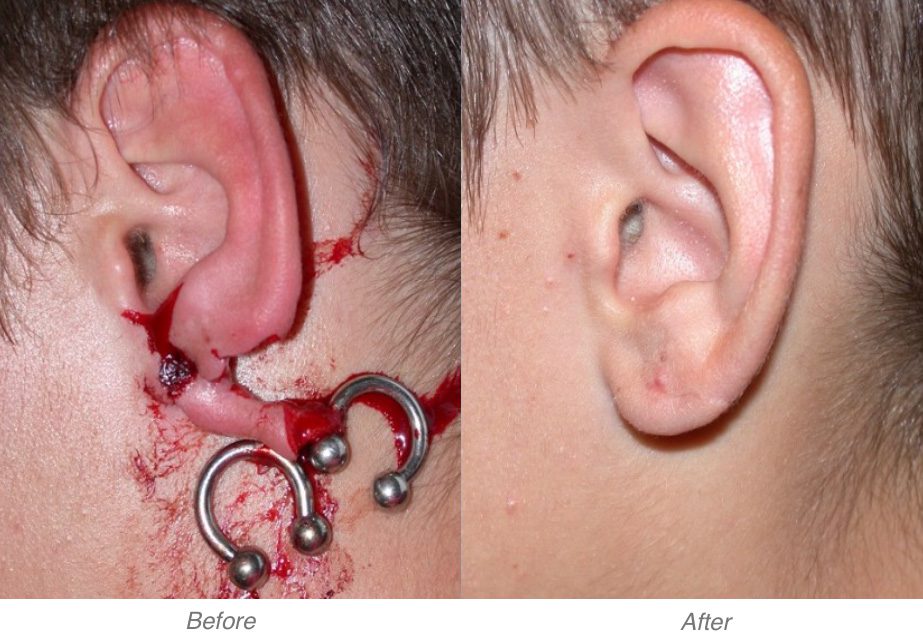Earlobe repair surgery provides a transformative solution for individuals seeking to restore the natural shape and integrity of their earlobes. Whether caused by the use of gauge piercings, accidental tearing, or other forms of injury, earlobe damage can significantly affect one's appearance. Gauge Earlobe Repair, a common procedure in cosmetic surgery, offers an effective method to reverse such damage and rejuvenate the earlobes.
This post provides a detailed, professional overview of earlobe repair surgery, including the different types of procedures, the process itself, and what one can expect during recovery.
Introduction to Earlobe Repair Surgery
Earlobe repair surgery is an increasingly popular cosmetic procedure aimed at correcting earlobe damage, especially for those who have experienced tearing or stretching from large gauge piercings. Gauge Earlobe Repair specifically targets individuals with stretched lobes, restoring them to their natural form. For many, the decision to undergo earlobe repair is driven by the desire to return to a more youthful appearance or to address functional concerns, such as difficulty wearing earrings due to the damaged earlobe.
Performed under local anesthesia, earlobe repair is minimally invasive, with a quick recovery time. This procedure has gained recognition for its simplicity, effectiveness, and the impressive results it offers, making it a sought-after option for individuals looking to enhance the overall aesthetic of their ears.
Types of Earlobe Repair Procedures
Earlobe repair surgeries are not one-size-fits-all. The technique and approach used during the procedure will depend on the specific type of damage present. Below are the two most commonly performed types of earlobe repair surgeries:
1. Gauge Earlobe Repair
For individuals with stretched earlobes due to the use of gauges, Gauge Earlobe Repair is the most suitable option. Over time, wearing large gauges can cause the earlobe to elongate and thin, sometimes leading to tears or splits. The surgical process involves removing the stretched tissue, reshaping the earlobe to its original size and shape, and suturing the area for healing. This procedure allows individuals to regain the ability to wear earrings without concerns about discomfort or further damage.
2. Split Earlobe Repair
Another prevalent procedure is Split Earlobe Repair, which is designed for individuals who have torn or split their earlobes. This can occur when an earring is pulled or snagged or as a result of trauma. In this surgery, the surgeon carefully cleans and stitches the split area together, restoring the earlobe's natural appearance. The repair typically involves minimal scarring, and once healed, the earlobe is fully functional and aesthetically pleasing, allowing the individual to wear jewelry comfortably.
The Procedure: What to Expect
Earlobe repair surgery is generally performed in an outpatient setting and requires only local anesthesia. This means the patient will be awake throughout the procedure but will not experience any pain. The surgery typically lasts between 30 minutes and an hour, depending on the complexity of the repair.
For Gauge Earlobe Repair, the surgeon will first assess the extent of the damage caused by the gauges, remove excess tissue, and carefully reconstruct the earlobe to its original contour. In cases of Split Earlobe Repair, the surgeon will clean the wound, remove any damaged tissue, and stitch the edges of the tear back together.
While the procedure is relatively quick, the expertise of the surgeon plays a crucial role in ensuring a successful outcome. Precision in reshaping the earlobe is necessary for achieving natural-looking results with minimal scarring.
Recovery and Aftercare
Post-surgery recovery for earlobe repair is typically brief and straightforward. However, following proper aftercare instructions is essential to ensure optimal results:
Cleaning and Protection: Gently clean the earlobe with prescribed solutions to prevent infection. Keep the area dry and avoid any direct pressure on the earlobe.
Rest and Avoidance of Jewelry: Refrain from wearing earrings for several months while the earlobe heals. This will help avoid unnecessary tension or irritation on the repaired area.
Follow-up Appointments: Attend all scheduled follow-up appointments to allow the surgeon to monitor healing progress and address any concerns.
Most patients can return to normal activities within one to two weeks after surgery, although it is advisable to avoid strenuous physical activity during the initial healing phase.
Benefits of Earlobe Repair Surgery
The benefits of earlobe repair surgery extend beyond aesthetic improvement. Many patients report a significant boost in self-confidence after the procedure, especially those who have experienced social or professional discomfort due to damaged earlobes. Furthermore, Split Earlobe Repair can restore the functionality of the earlobe, making it easier to wear earrings without pain or worry of further injury.
For individuals with stretched lobes due to the use of gauges, Gauge Earlobe Repair offers the opportunity to return to a more conventional earlobe appearance while preserving the ability to adorn their ears with jewelry in the future. Ultimately, earlobe repair is not only about cosmetic enhancement but also about improving comfort and self-expression.
Final Thoughts
Earlobe repair surgery provides a highly effective solution for individuals seeking to restore the natural form of their earlobes, whether due to damage from gauges or tears. The procedures of Gauge Earlobe Repair and Split Earlobe Repair offer personalized, minimally invasive options to achieve a more youthful, functional appearance.
With proper care and attention, the results of earlobe repair surgery can be both long-lasting and satisfying, enabling individuals to enjoy wearing earrings again with confidence. If you are considering this procedure, consult with a qualified surgeon to discuss the best approach to restoring your earlobes to their optimal state.





Comments